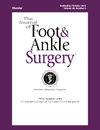Brostrom-Gould治疗踝关节不稳定后心理健康、疼痛和功能的间隔变化:一项回顾性队列研究
IF 1.3
4区 医学
Q2 Medicine
引用次数: 0
摘要
本研究旨在评估慢性踝关节不稳(CAI)患者Brostrom-Gould (BG)手术后患者报告结果的间隔变化。我们的主要兴趣是确定患者心理健康,身体功能和疼痛的重大变化时期,为患者提供有关术后期望的适当咨询参考。本研究设计为回顾性队列研究。通过CPT代码和对同一家机构从2022年7月到2024年2月的手术安排记录的广泛审查,确定了78名患者。纳入标准仅限于年龄≥16岁,诊断为CAI并进行初级BG手术并完成术前患者报告结果(PRO)评估的患者。术前和术后在指定的时间间隔前瞻性地收集PROs。PROs包括患者报告结果信息管理系统(PROMIS)、身体功能(PF)、疼痛干扰(PI)和全球10心理健康(MH)。通过回顾性图表分析收集患者的社会人口统计资料和既往病史。纳入的40例患者术前平均MH为50.4 [SD= 9.04], PF为41.0 [SD= 6.75], PI为61.8 [SD=7.0]。在PROMIS PF (p< 0.0001)、PI (p< 0.0001)和MH (p= 0.4830)中,PROMIS平均评分相对于基线的变化。PF和PI的最大改善发生在6周到3个月之间。目前的研究表明,接受BG的患者可以预期在手术的第一年身体功能的显著改善和疼痛的减轻,最早在术后6周开始。这些发现可用于临床实践,以适当地咨询患者术后对手术的期望。本文章由计算机程序翻译,如有差异,请以英文原文为准。
Interval changes in mental health, pain, and function following Brostrom-Gould for ankle instability: A retrospective cohort study
This study aims to assess interval changes in patient-reported outcomes following Brostrom-Gould (BG) surgery in patients with Chronic Ankle Instability (CAI). Our primary interest is to identify periods of significant change in patient mental health, physical function, and pain to provide a reference to appropriately counsel patients regarding postoperative expectations. This study was designed as a retrospective cohort study. Seventy-eight patients were identified via CPT codes and an extensive review of the surgical scheduling record at a single institution from July 2022 to February 2024. Inclusion criteria were restricted to patients age ≥16, a diagnosis of CAI undergoing a primary BG procedure with completed preoperative patient-reported outcome (PRO) assessments. PROs were prospectively collected preoperatively and at designated postoperative intervals. PROs included Patient Reported Outcome Information Management System (PROMIS) Physical Function (PF), Pain Interference (PI), and Global-10 Mental Health (MH). Patient sociodemographic data and past medical history were collected via retrospective chart review. Among the 40 patients included, the mean preoperative MH was 50.4 [SD = 9.04], PF was 41.0 [SD = 6.75], and PI was 61.8 [SD = 7.0]. Changes in mean PROMIS scores relative to baseline were seen in PROMIS PF (p < 0.0001), PI (p < 0.0001), and MH (p = 0.4830). The greatest improvement in PF and PI occurred between 6 weeks and 3 months. The present study suggests that patients undergoing BG can expect significant improvement in physical function and a reduction of pain within the first year of surgery, beginning as early as 6 weeks postoperatively. These findings may be used in clinical practice to appropriately counsel patients regarding post-operative expectations following surgery.
求助全文
通过发布文献求助,成功后即可免费获取论文全文。
去求助
来源期刊

Journal of Foot & Ankle Surgery
ORTHOPEDICS-SURGERY
CiteScore
2.30
自引率
7.70%
发文量
234
审稿时长
29.8 weeks
期刊介绍:
The Journal of Foot & Ankle Surgery is the leading source for original, clinically-focused articles on the surgical and medical management of the foot and ankle. Each bi-monthly, peer-reviewed issue addresses relevant topics to the profession, such as: adult reconstruction of the forefoot; adult reconstruction of the hindfoot and ankle; diabetes; medicine/rheumatology; pediatrics; research; sports medicine; trauma; and tumors.
 求助内容:
求助内容: 应助结果提醒方式:
应助结果提醒方式:


